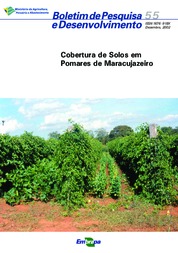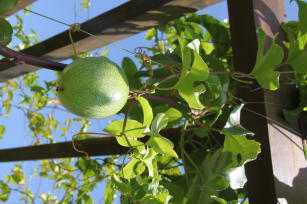Cobertura de solos em pomares de maracujazeiro.
Cobertura de solos em pomares de maracujazeiro.
Author(s): ANDRADE, L. R. M. de; ICUMA, I. M.; JUNQUEIRA, N. T. V.; KARIA, C. T.; CARVALHO, A. M. de; VIVALDI, L. J.
Summary: RESUMO: Este trabalho teve como objetivo avaliar a adequação das espécies leguminosas Crotalaria spectabilis, guandu-anão, feijão-de-porco e amendoim forrageiro ao sistema de plantio em consórcio com maracujá amarelo (Passiflora edulis f. flavicarpa Deg.). À exceção do amendoim forrageiro, cujo cescimento inicial é lento, as espécies apresentaram boa taxa de cobertura do solo nos primeiros 30 dias de seu plantio. As leguminosas influenciaram a densidade da fauna de insetos visitantes, sendo os grupos Diptera e Hymenoptera os mais freqüentes. Nas plantas de maracujá, o nematóide-de-galha Meloidogyne ocorreu principalmente nas parcelas com feijão-de-porco, mas não foram observados efeitos negativos na produção dos frutos. A presença das leguminosas entre as linhas afetou a produção de frutos de maracujá e o teor de nutrientees (P, S e Cu) nas folhas. O P nas folhas foi correlacionado com P no solo entre as linhas, mas não com a atividade de enzimas fosfatase ou com a colonização das raízes por fungos micorrízicos (MVA). O cultivo entre as linhas afetou os parâmetros químicos do solo na camada de 0 a 5 cm de profundidade. Os resultados indicam que para uma espécie ser recomendada para consórcio em pomar de maracujazeiro, além da taxa de cobertura do solo outros parâmetros (susceptibilidade a pragas e doenças, ciclagem de nutrientees, competição com a cultura etc.) devem ser considerados. ABSTRACT: This work was carried out to evaluated the impact of cover crops species in the nutrient cycling, soil quality, and passionfruit (Passiflora edulis) (PF) fruit productivity. The treatments consisted of four leguminous species: forage Arachis pintoi, Crotalaria spectabilis, Canavalia ensiformis, Cajanus cajan, cultivated in the interrow area, plus a control treatment (spontaneous species). In the first year, there was a significant effect of the cover crop on PF fruit prodution and on P, S and Cu concentration in leaves. The highest fruit productions were observed in the A. pintoi and the control treatments. The highest concentration of P was found in PF plants cultivated with C. ensiformis. Nevertheless, neither colonization of plant roots by vesicular-arbuscular mycorrhizal (VAM) fugi nor soil phosphatase activity, nor soil P content could explain the differences in P concentration in tissue. The cover crop and PF plants increased the number of VAM spores in the soil. C. spectabilis negatively affected the S content in PF plants tissue. The fruit production was significantly correlated with the content of S in tissue, but not with the soil sulfatese acitivity. In the control treatment, PF plants accumulated less Cu than with cover crops species. Biochemical parameters such as soil phosphatase and arylsulfatase activities were not significantly different among treatments, which possibly is related with the soil fertility levels. In PF rows, the root-knot Meloidogyne nematode was found mainly associated with C. spectabilis treatment. However, no negative effects on PF fruit production were associated with the presence of this plant-parasite.
Publication year: 2002
Types of publication: Booklets
Unit: Embrapa Cerrados
Observation
Some of Embrapa's publications are published as ePub files. To read them, use or download one of the following free software options to your computer or mobile device. Android: Google Play Books; IOS: iBooks; Windows and Linux: Calibre.
Access other publications
Access the Agricultural Research Database (BDPA) to consult Embrapa's full library collection and records.
Visit Embrapa Bookstore to purchase books and other publications sold by Embrapa.


